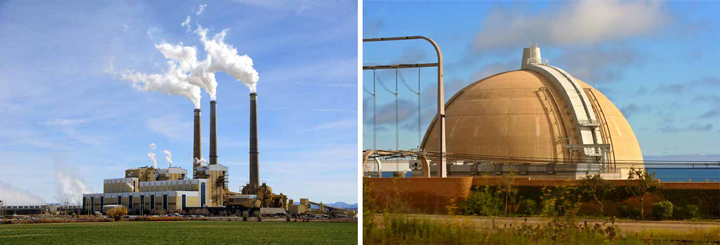Researchers Unravel Age-Old Mystery of Why Cells Use Fermentation
December 2, 2015
By Kim McDonald

What the researchers discovered about the strategy most cells use to generate energy could be compared to the difference between generating energy by a coal plant, at left, and a nuclear power plant, at right
istockphoto ©helt2 ©FauxCastor
Wine, beer and yogurt are produced when microorganisms convert sugar into alcohol, gases or acids. But this process of fermentation—which is used by bacteria, fungi and other fast-growing cells to generate energy in the absence of oxygen—is a much less efficient way of generating energy for cells than aerobic respiration.
So why do many organisms use this seemingly wasteful strategy to generate energy instead of aerobic respiration, even when oxygen is readily available?
Biologists have pondered this conundrum for nearly a century and dubbed it the "Warburg effect" after the Nobel-Prize winning cell biologist Otto Warburg. He discovered in the 1920s that cancer cells generate energy by fermenting glucose, which generates a great deal of metabolic waste such as lactic acid.
Heavy usage of glucose by fermentation is, in fact, how tumors are identified in PET scans. But if this process is so inefficient, Warburg and others wondered, why do so many organisms depend on it instead of using the more efficient process of aerobic respiration?
A team of physicists and biologists from UC San Diego may have finally found the answer to this nearly 100-year-old mystery. In this week’s issue of the journal Nature, the researchers examined the metabolic costs of synthesizing the enzymes and other biological apparatus required for fermentation and aerobic respiration within the bacterium E. coli as well as the metabolic savings of generating energy through aerobic respiration. They found that the cost of protein synthesis overrules the metabolic savings for fast growing cells.
"What we discovered could be compared to the difference between generating energy by a coal factory versus a nuclear power plant," said Terry Hwa, a professor of physics and biology at UC San Diego who headed the study. "Coal factories produce energy less efficiently than nuclear power plants on a per-carbon basis, but they are a lot cheaper to build. So the decision of which route to generate energy depends on the availability of coal and the available budget for building power plants."
"For cells, it turns out that there are also two costs to consider," he added. "One is the cost of raw material. Aerobic respiration generates more energy per carbon atom than fermentation. The other is the opportunity cost of synthesizing enzymes. This cost refers to the number of the protein-making machinery, or ribosomes, that need to be recruited to synthesize the relevant enzymes. We showed that the enzymes for respiration are bulky and slow compared to those for fermentation, so a lot of such enzymes need to be synthesized, tying up a lot of ribosomes, in order for respiration to happen at substantial rates. This is an important cost because the number of ribosomes is the growth limiting factor."
"For fast growing cells with plenty of nutrients, if a lot of ribosomes are used to make respiratory enzymes, then few of them are available to make other growth proteins, including the ribosomes themselves. This would slow down growth and is disadvantageous to cells. The higher carbon efficiency of respiration is not an important consideration here since nutrients are plentiful. On the other hand, when nutrients are scarce and cells cannot grow fast, then the demand for ribosomes by other cellular functions is reduced, and the cost of tying up ribosomes is less important. In the meantime, using respiration to generate energy conserves the precious carbon supplies, which is a much more important consideration in poor nutrient conditions."
"Of these two costs the cell needs to consider when generating energy, the cost of carbon is universally recognized, that is, respiration is more carbon-efficient. What we established in this study is that the cost of making the energy-generating apparatus is also substantial, and is in fact the dominant cost for fast growing cells."
The idea of this opportunity cost to cell growth was first suggested several years ago by a team of theoretical biologists from the Netherlands. In the UC San Diego study, Hwa and his collaborators experimentally characterized the cost of synthesizing fermentation versus respiratory enzymes by using proteomic mass spectrometry and discovered that respiratory proteins are twice as expensive as fermentation proteins for the same rate of energy generation. Their study is the first time such a cost has been established for any living system. The researchers also developed a mathematical model that quantitatively predicted the pattern of metabolic waste excretion in response to perturbations they applied to affect the physiological state of growing cells.
While it is not clear whether the same rationale underlies the origin of "wasteful metabolism" in cancer, the researchers said, they believe their results provide another way to think about the process.
"Instead of something going wrong that should be fixed, this may be the universal strategy necessary for rapidly growing cells," explained Hwa. "The results may also have implications in biotechnology: metabolic engineers are always trying to reduce metabolic waste in engineered organisms in order to reduce cost. Our findings suggest that reducing waste may be detrimental to the organisms and different strategies need to be devised to increase metabolic efficiency."
Other co-authors of the study were UC San Diego scientists Markus Basan, Sheng Hui, Hiroyuki Okano, Zhongge Zhang and Yang Shen, and James Williamson of The Scripps Research Institute in La Jolla. The study was funded by grants from the National Institutes of Health (R01-GM109069), Simons Foundation, Walter Haefner Foundation and the ETH Foundation.
UC San Diego News on the web at: http://ucsdnews.ucsd.edu
